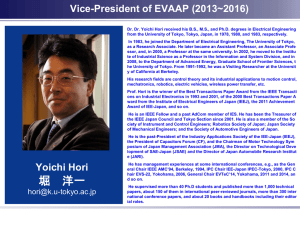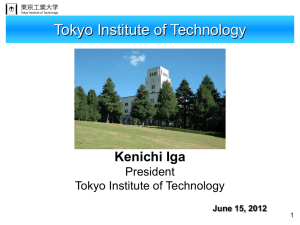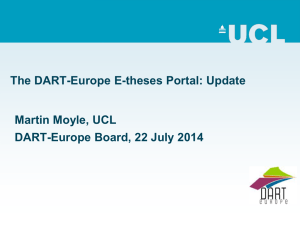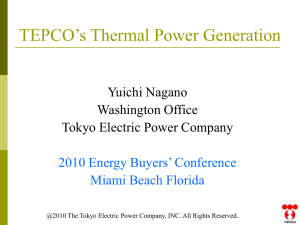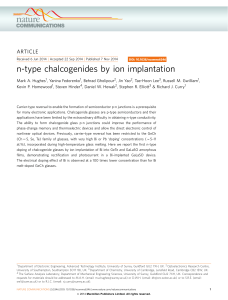(Ge,Mn)Te
advertisement
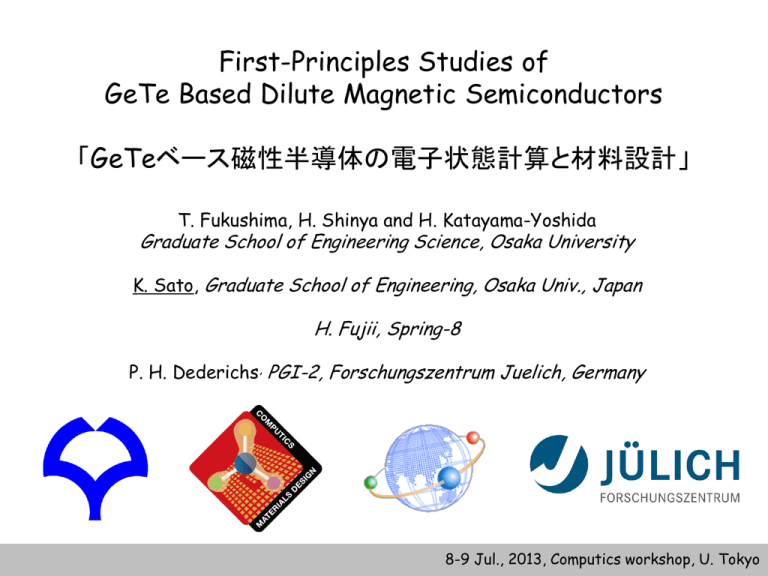
First-Principles Studies of GeTe Based Dilute Magnetic Semiconductors 「GeTeベース磁性半導体の電子状態計算と材料設計」 T. Fukushima, H. Shinya and H. Katayama-Yoshida Graduate School of Engineering Science, Osaka University K. Sato, Graduate School of Engineering, Osaka Univ., Japan H. Fujii, Spring-8 P. H. Dederichs, PGI-2, Forschungszentrum Juelich, Germany 8-9 Jul., 2013, Computics workshop, U. Tokyo 研究組織 「スピンエレクトロニクス材料の探索」 • 研究代表者 – 佐藤和則(阪大基礎工 ⇒ 阪大工) • 研究分担者 – 小田竜樹(金沢大数理) – 野崎隆行(産総研) • 連携研究者 – – – – – – – 小倉昌子(阪大理 ⇒ ミュンヘン・ルートヴィヒ・マクシミリアン大学) 黒田眞司(筑波大) 鈴木義茂(阪大基礎工) 朝日一(阪大産研) 吉田博(阪大基礎工) 下司雅章(阪大ナノ) 赤井久純(阪大理 ⇒ 東大物性研) 8-9 Jul., 2013, Computics workshop, U. Tokyo Outline Introduction Dilute magnetic semiconductor (DMS) GeTe based IV-VI type DMS Computational method Result Defect formation energy in GeTe Magnetic properties in TM doped GeTe Hole doping in (Ge,Mn)Te Summary 8-9 Jul., 2013, Computics workshop, U. Tokyo Dilute magnetic semiconductors (DMSs) (Ga,Mn)As • Carrier induced ferromagnetism • • (In, Mn)As; TC = 60 (K) (Ga, Mn)As; TC = 190 (K) Problem 468 K Curie temperature < room temperature Low solubility of transition metal Solution Low-temperature MBE + post-annealing Co-doping method + post-annealing GeTe based DMS K. Sato, et al., Rev. Mod. Phys. 82, 1633 (2010) T. Yamamoto et al.: Jpn. J. Appl. Phys. 36 (1997)L180. K. Sato et al.: Jpn. J. Appl. Phys. 46 (2007) L1120. H. Fujii, et al.: Appl. Phys. Express. 4 (2011) 043003. 8-9 Jul., 2013, Computics workshop, U. Tokyo GeTe and (Ge,Mn)Te Mn 8% doped GeTe GeTe Ferroelectric semiconductor NaCl to Rhombohedral transformation at 440°C Phase-changed material (PCM) Ex: (Ge,Mn)Te • No miscibility gap below 50% of Mn • Alloying over wide range of concentration Y. Fukuma et al., Appl. Phys. Lett. 93 (2008) 252502. W. D. Johnston et al., J. Inorg. Nucl.Chem. 19 (1961) 229. 8-9 Jul., 2013, Computics workshop, U. Tokyo Computational method H. Akai: http://sham.phys.sci.osaka-u.ac.jp/kkr/ https://www.vasp.at TM Ge Te Rocksalt structure Local density approximation (LDA) Scalar relativistic approximation Coherent potential approximation (CPA) lmax=2, energy mesh=60 8-9 Jul., 2013, Computics workshop, U. Tokyo Band structure of GeTe compound Top of valence band Ge GeTe Ge-4s Te-5p antibonding state Te 5 Ge-4p 4p 4p 0 Te-5p 5p 5p Energy (eV) s-p interaction EF -5 Ge-4s 4s 4s -10 5s 5s Te-5s -15 Hole carriers stabilization of the crystal p-type conductivity X Z W Q L L G D X K S S G 8-9 Jul., 2013, Computics workshop, U. Tokyo Native defects and TM impurities in GeTe Formation energy (FE) Formation energy (eV) 2 Ge-rich Te-rich VTe VTe VGe: Ge vacancy VTe: Te vacancy Mns: substitutional Mn 1 Crs 0 Mns Mns VGe -1 -0.4 -0.2 0 Crs: substitutional Cr Crs High solubility for Ge vacancy and TM impurities VGe 0.2 0.4-0.4 EF (eV) -0.2 0 0.2 0.4 8-9 Jul., 2013, Computics workshop, U. Tokyo Calculation of magnetic properties of DMS by KKR-Green’s function method K. Sato et al., RMP 82 (2010) 1633., L. Begqvist et al., PRL 93 (2004) 137202 K. Sato et al., PRB 70 (2004) 201202 Exchange interactions by Liechtenstein’s formula _ Energy difference due to the rotation is mapped to Classical Heisenberg model (Liechtenstein et al.) :exchange interaction in a CPA medium CPA medium • KKR-CPA-LDA → MACHIKANEYAMA2002 (H. Akai) _ :direction of magnetic moment Statistical method for TC – Mean field approximation (MFA) – Random phase approximation (RPA) – Monte Carlo simulation (MCS) DOSs of TM (10%) doped GeTe DOS (1/eV) 2 V Mn Co Ni -15 -10 -5 0 Energy (eV) -15 -10 -5 0 Energy (eV) 1 0 -1 Total TM-3d -2 2 DOS (1/eV) Cr Fe 1 0 -1 -2 -15 -10 -5 0 Energy (eV) 8-9 Jul., 2013, Computics workshop, U. Tokyo Double exchange vs. p-d exchange interaction K. Sato, et al., Rev. Mod. Phys. 82, 1633 (2010) Double exchange interaction p-d exchange interaction Wave functions of impurity band in band gap decay exponentially Ferromagnetism is stabilized by polarization of valence state Short ranged interaction Long ranged interaction 8-9 Jul., 2013, Computics workshop, U. Tokyo Exchange coupling constants in TM doped GeTe Jij (mRy) 2 Ferro V Antiferro 5% 10% 20% Mn Co Ni 1 0 -1 -2 2 Jij (mRy) Cr Fe 1 0 -1 -2 0 1 2 3 d/a 40 1 2 3 d/a 40 1 2 3 d/a 4 8-9 Jul., 2013, Computics workshop, U. Tokyo Hole doping in (Ge,Mn)Te by Ga vacancy 3 Total Mn DOS (1/eV) 2 1 0 -1 VGa: 10% -2 -3 -15 -10 -5 0 Exchange coupling constant (meV) Energy relative to Fermi energy (eV) 8 6 By hole doping ferromagnetic state is stabilized. Half-metallic DOS Mn2+(d5) + hole Localized d-states Holes in valence bands 4 2 p-d exchange interaction 0 stabilizes ferromagnetic state -2 Vc:0% Vc:5% Vc:10% Vc:20% -4 -6 -8 0 0.5 1 1.5 2 2.5 3 Distance/lattice constant 3.5 4 4.5 8-9 Jul., 2013, Computics workshop, U. Tokyo TC of (Ge,Cr)Te and (Ge,Mn)Te + VGe 400 MFA 350 RPA MCS 300 250 200 150 100 (Ge,Cr)Te 50 Curie temperature (K) Curie temperature (K) 400 MFA 350 RPA MCS 300 250 200 150 100 (Ge,Mn)Te + VGe:20% 50 0 0 0 10 20 30 40 Cr concentration (%) 50 0 10 20 30 40 50 Mn concentration (%) 8-9 Jul., 2013, Computics workshop, U. Tokyo Conclusion Electronic structure and magnetic properties of GeTe based DMS are investigated by Akai-KKR code and VASP code. High solubilities of transition metals can be expected. Ferromagnetism is stable for V, Cr, and Fe doped GeTe. Vge stabilizes ferromagnetism in (Ge,Mn)Te. Curie temperatures of (Ge,Cr)Te and (Ge,Mn,VGe)Te reach room temperature. 8-9 Jul., 2013, Computics workshop, U. Tokyo Electronic structure of GeMnTe • • • • x=0.2 (EPMA) Mn 3p-3d resonant photoemission Partial DOS of Mn-3d Energy res. = 150 meV • Main peak at 3.8 eV • Broad feature at 8 and 1 eV • Similar to GaMnAs • LDA: Mn-3d at ~3 eV Senba et al., J. Electron Spectros. Relat. Phenom. 144-147 (2005) 629 8-9 Jul., 2013, Computics workshop, U. Tokyo


